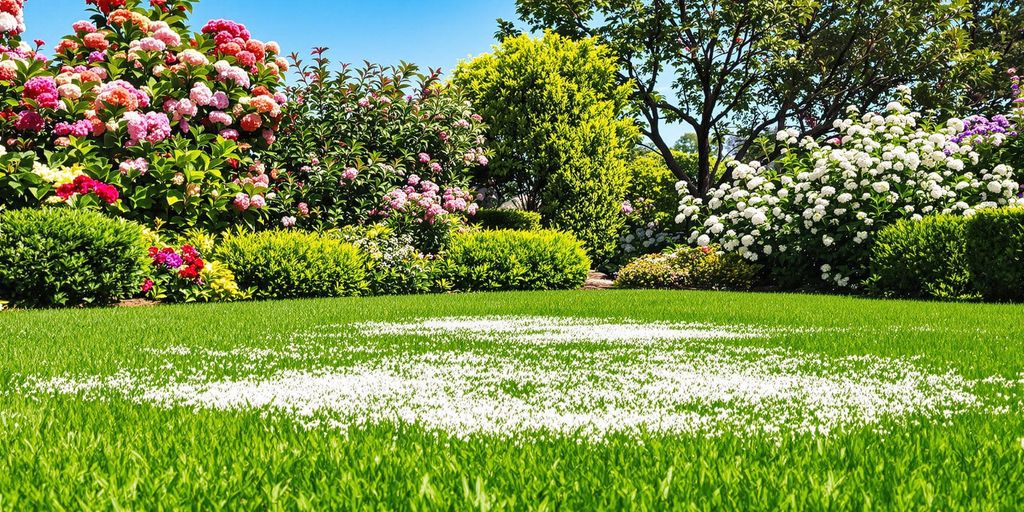
Taking care of your lawn in Fort Worth can feel like a full-time job, especially with the unique climate and soil in the area. But don’t worry, having a solid annual lawn fertilizer schedule can make it way easier. This guide is here to help you figure out what your lawn needs, when it needs it, and how to keep it looking great all year long.
Key Takeaways
- Fort Worth’s climate and soil play a big role in how and when you should fertilize your lawn.
- Choosing the right fertilizer—whether organic or synthetic—can make a huge difference.
- Spring is the best time to kick off your lawn care routine with the right nutrients.
- Summer lawn care requires balancing fertilizer use with proper watering to handle the heat.
- Fall fertilization sets your lawn up to stay strong through the winter months.
Understanding Fort Worth’s Climate and Soil
Key Characteristics of Fort Worth’s Climate
Fort Worth sits in a region with a humid subtropical climate, which means hot summers and mild winters. Summers can easily hit triple digits, while winters rarely see prolonged freezes. This unique blend of heat and mildness shapes how your lawn grows year-round. Rainfall is fairly evenly distributed, but summer tends to dry out quickly, so watering becomes essential. For expert lawn care and maintenance in this climate, call us today to keep your lawn healthy and vibrant year-round!
Common Soil Types in Fort Worth Lawns
The soil in Fort Worth is a mix of clay, sandy loam, and occasionally rocky textures. The dominant clay soils hold water well but can compact easily, making aeration a key task. On the other hand, sandy soils drain quickly, so they need more frequent watering and fertilization to maintain nutrient levels. For a thriving lawn, it’s important to understand which type you have.
| Soil Type | Water Retention | Nutrient Holding | Common Issues |
| Clay | High | High | Compaction, poor drainage |
| Sandy | Low | Low | Quick drying, nutrient loss |
| Loamy | Moderate | Moderate | Rare but needs balance |
How Climate and Soil Affect Fertilizer Needs
The combination of Fort Worth’s climate and soil directly impacts how and when to fertilize. For example:
- Clay soils benefit from slow-release fertilizers to avoid overloading nutrients.
- In sandy soils, more frequent applications of quick-release fertilizers might be necessary.
- Summer heat can stress lawns, making proper fertilization and watering critical.
A well-timed soil test can uncover what your lawn truly needs. Enhancing soil quality in Fort Worth starts with understanding your soil’s pH, nutrient levels, and organic content. This simple step helps you avoid over-fertilizing or wasting resources.
Choosing the Right Fertilizer for Your Lawn
Types of Fertilizers for Fort Worth Lawns
Fertilizer can be a game-changer for your lawn renovation, but not all types are created equal. For Fort Worth lawns, the most common options include:
- Nitrogen-rich fertilizers: These promote green, lush growth. Look for formulations with slow-release nitrogen for steady feeding.
- Phosphorus-based fertilizers: Often used for new lawns or struggling grass, phosphorus helps with root development.
- Potassium-heavy blends: These are ideal for strengthening grass, especially before stressful seasons like summer or winter.
Each type has its own purpose, so knowing your lawn’s needs is the first step.
Organic vs. Synthetic Fertilizers
When it comes to organic and synthetic fertilizers, both have their perks. Organic fertilizers, like compost or manure, improve soil health over time. They release nutrients slowly, which is great for long-term growth. Synthetic fertilizers, on the other hand, deliver nutrients quickly and are easy to apply. The choice often depends on your priorities—soil health or quick results.
Reading Fertilizer Labels Effectively
Understanding a fertilizer label is crucial. The three numbers on the bag (e.g., 10-10-10) represent nitrogen, phosphorus, and potassium (N-P-K) content. For Fort Worth lawns, a balanced formula like 16-4-8 often works well. Always check the label for:
- The percentage of each nutrient.
- Whether the nitrogen is slow-release.
- Any added micronutrients like iron or magnesium.
A little label-reading can save you a lot of trouble later. It ensures you’re giving your lawn exactly what it needs, without overdoing it.
For best results, apply no more than three pounds of nitrogen annually, with a maximum of one pound per application. Adjust these amounts based on soil test results to avoid over-fertilizing and harming your lawn.
Spring Fertilization Tips for Fort Worth Lawns
When to Start Spring Fertilization
Timing is everything when it comes to fertilizing your lawn in Fort Worth. The best time to apply fertilizer is when your grass starts actively growing, usually in late March to early April. You’ll want to wait until the soil temperature consistently reaches around 55°F, as this signals that your lawn is waking up from dormancy. Avoid fertilizing too early, as it can lead to wasted nutrients and uneven growth.
Best Fertilizer Formulas for Spring
For spring, choose a fertilizer with a balanced ratio of nitrogen, phosphorus, and potassium (NPK). A 20-5-10 formula works well for most Fort Worth lawns. Here’s a quick breakdown of what these nutrients do:
| Nutrient | Purpose |
| Nitrogen (N) | Promotes lush, green growth |
| Phosphorus (P) | Encourages strong root development |
| Potassium (K) | Boosts overall lawn health and resistance |
If you’re unsure about your soil’s needs, consider doing a soil test to determine the right nutrient mix. You can find kits at local garden centers or through lawn care services.
Common Mistakes to Avoid in Spring
Spring fertilization can be tricky if you’re not careful. Here are some common pitfalls to steer clear of:
Over-fertilizing: Applying too much can burn your grass and harm the environment by causing runoff into waterways.
Skipping watering: Fertilizer needs moisture to soak into the soil, so water your lawn lightly after application.
Using the wrong type of fertilizer: Make sure the formula matches your lawn’s specific needs, especially if you have Bermudagrass or St. Augustine grass, which are common in Fort Worth.
A little attention to detail in spring can set the stage for a thriving lawn all year long. Don’t rush the process—let the grass tell you when it’s ready for that first feed.
Need help with your lawn care? Call us today! We’ll ensure your lawn gets the perfect start this season.
Summer Lawn Care and Fertilization
Managing Heat Stress in Fort Worth Lawns
Summers in Fort Worth can be brutal on lawns, with scorching temperatures and unpredictable rainfall. The key to keeping your lawn alive during this season is proper care and preparation. Start by mowing your grass at a slightly higher setting to provide shade for the soil and retain moisture. It’s also smart to water deeply but less frequently—this encourages roots to grow deeper into the soil where water is retained longer. Avoid mowing during the hottest parts of the day to reduce stress on the grass.
A little effort in the summer can make the difference between a thriving lawn and one that’s struggling to survive.
Ideal Fertilizer Types for Summer
When it comes to fertilizing during the summer months, you want to be cautious. Over-fertilizing can stress your lawn, especially in the heat. Look for slow-release fertilizers with a balanced mix of nitrogen, phosphorus, and potassium. These formulas provide steady nutrients without overwhelming the grass.
Here’s a simple table to help you choose:
| Fertilizer Type | Benefits | Application Frequency |
| Slow-Release | Steady feeding, less stress | Every 6-8 weeks |
| Organic | Gentle on soil, eco-friendly | Monthly |
| Liquid Fertilizers | Quick absorption, temporary boost | Every 3-4 weeks |
Watering and Fertilization Balance
Balancing water and fertilizer is critical in the summer. Fertilizer needs moisture to activate, but too much water can wash it away. Water your lawn early in the morning to reduce evaporation and give the grass time to absorb nutrients. After fertilizing, follow up with a light watering to help the product soak into the soil.
Here are some quick tips:
- Always read the instructions on your fertilizer for watering guidelines.
- Avoid fertilizing right before heavy rain is expected—it’s a waste of product and harmful to runoff areas.
- Monitor your lawn’s color and growth; signs of stress may mean adjusting your watering schedule.
For more on the best times to fertilize in North Texas, check out optimal lawn fertilization practices.
Fall Fertilization Strategies for a Healthy Lawn
Why Fall Fertilization is Crucial
Fall is the unsung hero of lawn care. It’s the season when your grass gets a chance to recover from the summer heat and prepare for the colder months ahead. Applying the right fertilizer in autumn strengthens the roots, setting your lawn up for success next spring. During this time, grass stores nutrients, so it’s ready to grow thick and green when temperatures rise again. Skipping fall fertilization means missing out on this critical recovery period.
Best Fertilizer Options for Fall
Choosing a fertilizer with a balanced mix of nutrients is key for fall care. Look for products that include:
- Nitrogen: Helps keep the grass green and promotes growth.
- Phosphorus: Supports root development.
- Potassium: Boosts disease resistance and overall health.
For Fort Worth lawns, slow-release nitrogen fertilizers like essential lawn services are a great pick. They provide steady nourishment over time, ensuring your grass stays healthy without sudden growth spurts.
Preparing Your Lawn for Winter
Getting your lawn ready for winter isn’t just about fertilizing. Here’s a quick checklist to follow:
- Mow one last time: Keep the grass at a moderate height to prevent matting under snow or frost.
- Aerate the soil: This allows nutrients and water to penetrate deeper into the roots.
- Remove debris: Clear leaves and branches to avoid suffocating the grass.
Don’t underestimate the power of fall prep. A little effort now can mean less work and a better-looking lawn come spring.
Dealing with Lawn Pests and Weeds
Identifying Common Lawn Pests in Fort Worth
Fort Worth lawns can face a variety of pests, from chinch bugs to grub worms. These pests can wreak havoc, leaving your grass patchy and weak. Recognizing the early signs of pest damage is crucial to preventing widespread issues. For example:
- Chinch bugs often cause yellow or brown patches in sunny areas.
- Grub worms live underground and eat grass roots, leading to spongy, dying turf.
- Armyworms feed on grass blades, leaving a chewed-up appearance.
Take a close look at your lawn regularly. If you notice birds pecking at the grass, they might be feasting on grubs—a telltale sign of an infestation.
Using Fertilizers to Strengthen Grass Against Weeds
Healthy grass is your first line of defense against weeds. Fertilizers play a big role in this by promoting thick, robust growth that leaves no room for pesky invaders. When choosing a fertilizer, look for one balanced in nitrogen, phosphorus, and potassium. Nitrogen, in particular, helps grass grow densely, making it harder for weeds to take root.
Here’s a quick guide to timing your fertilization:
| Season | Fertilizer Type | Application Notes |
| Spring | High-nitrogen formula | Encourages green, thick growth |
| Summer | Slow-release blend | Maintains strength in the heat |
| Fall | High-potassium mix | Prepares lawn for winter |
When your lawn is thriving, it naturally crowds out weeds like crabgrass and dandelions.
Integrated Pest Management Techniques
Integrated Pest Management (IPM) combines prevention, monitoring, and targeted treatments to manage pests effectively. Instead of relying solely on chemicals, IPM emphasizes a balanced approach:
- Prevention: Keep your lawn healthy with proper mowing, watering, and fertilization.
- Monitoring: Regularly inspect for pests and their damage.
- Targeted Action: Use pesticides sparingly and only when needed. Opt for natural solutions like neem oil when possible.
A well-maintained lawn can handle minor pest issues without intervention. Focus on building resilience through consistent care.
By following these steps, you can maintain a lawn that’s both beautiful and resistant to pests and weeds. For more tips on creating a healthy and attractive lawn, check out our guidelines.
Year-Round Lawn Maintenance Practices
Mowing and Aeration Tips for Fort Worth Lawns
Keeping a lawn healthy means staying on top of mowing and aeration. Regular mowing keeps grass at the ideal height, which is usually around 2-3 inches for most Fort Worth lawns. Cutting too short can stress the grass, especially during the hot summer months. Aeration, on the other hand, helps the soil breathe. By poking small holes in the lawn, you allow water, air, and nutrients to reach the roots. Fall is often the best time for aeration, but spring works too if your lawn feels compacted.
Seasonal Watering Guidelines
Watering isn’t one-size-fits-all. In Fort Worth, your lawn’s needs change with the seasons. During spring and fall, watering twice a week is often enough. But in the scorching summer months, you might need to water three times a week to keep the grass from drying out. Make sure to water early in the morning to minimize evaporation. Overwatering can lead to shallow roots and even invite disease, so finding the right balance is key.
The Role of Soil Testing in Lawn Care
Soil testing might sound like overkill, but it’s one of the smartest moves for lawn care. A simple test can tell you what nutrients your soil is missing and whether the pH level is off. This info makes it easier to pick the right fertilizer and avoid overdoing it. Healthy soil is the foundation of a thriving lawn, so consider testing once a year, either in early spring or late fall.
A little attention to these year-round practices can save you a ton of hassle down the line. Your lawn will thank you for it by staying green and lush all year long. Ready for a healthier lawn? Contact us today for expert soil testing and tailored care recommendations!
Wrapping It Up
Taking care of your lawn in Fort Worth doesn’t have to be a headache. With a little planning and sticking to a schedule, you can keep your grass looking green and healthy all year long. Remember, the key is consistency—don’t skip those important steps like fertilizing at the right times and watering properly. Sure, it might take a bit of effort, but the payoff is worth it when you’re sitting outside on a lush, beautiful lawn. So grab your calendar, mark those dates, and get ready to enjoy a yard you can be proud of in 2025.
Frequently Asked Questions
What is the best time to fertilize my lawn in Fort Worth?
The best time to fertilize depends on the season. Spring and fall are usually ideal, but summer and winter may require specific care based on your lawn’s needs.
How do I choose between organic and synthetic fertilizers?
Organic fertilizers are natural and improve soil health over time, while synthetic ones work faster but may harm the environment. The choice depends on your goals and budget.
What kind of fertilizer should I use during the summer?
In summer, use a slow-release fertilizer that won’t stress your lawn during the heat. Look for one with lower nitrogen content.
Can I fertilize my lawn and control weeds at the same time?
Yes, some fertilizers come with weed control. These products can save time, but make sure they’re safe for your type of grass.
How often should I test my soil?
Testing your soil every 2-3 years is a good idea. This helps you know what nutrients your lawn needs.
What are common mistakes people make when fertilizing?
Common mistakes include over-fertilizing, using the wrong type of fertilizer, and not watering properly after applying it.

